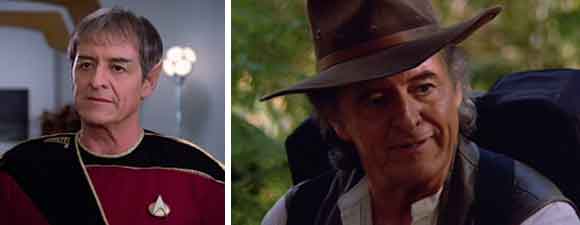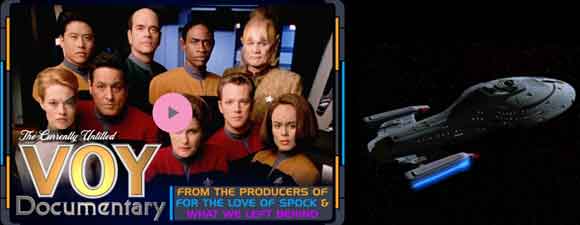Retro Review: The Raven
7 min read
theravenbanner
Seven of Nine suffers from hallucinations and steals a shuttle when an unknown signal activates her Borg implants.
Plot Summary: While Janeway encourages Seven of Nine to explore creativity in her Da Vinci holographic program, the Doctor tells Seven that it’s time for her to eat solid food. Voyager is approaching the B’omar Sovereignty, where Janeway hopes to negotiate for a shortcut home. When the ambassadors arrive and begin to list their demands, Seven sees visions of a large black bird swooping down on a ship while Borg attack her, causing her to attack Neelix, disable Tuvok’s security protocols, and steal a shuttle to leave the ship. The agitated B’omar warn Janeway that she must keep Voyager out of their space and advise her that they will capture and destroy the runaway Borg. Certain that there must be a scientific reason for Seven’s behavior since there are no Borg cubes without thousands of light years, Janeway sends Tuvok and Paris to track Seven, which they are able to do by hiding a modified shuttlecraft from the B’omar security grid. Tuvok has a hypospray from the Doctor with nanoprobes designed to shut down her newly activated Borg implants, but Janeway warns him that he must stop Seven by any means necessary if the hypospray doesn’t work. After fighting off B’omar ships and capturing Tuvok, Seven arrives at an M-class moon where she finds the ship from her hallucinations, broadcasting a homing signal that triggered her implants. It is the Raven, which Janeway has already identified as the Federation vessel brought by the Hansens with their daughter Annika into the Delta Quadrant. This, Seven realizes, is where she was captured by the Borg. While Paris heads toward the moon to rescue Seven and Tuvok, Janeway takes Voyager into B’omar space to retrieve all her crewmembers. The hostilities with the B’omar require months of travel to be added to their journey, yet Janeway is pleased to find that Seven is more willing to explore her humanity and to think about what her life might have been like had she been raised by her parents instead of the Borg.
Analysis: Most of us have aspects of Star Trek that we love so much, they compel us to overlook flaws that might be deal-breakers in a different franchise. But we don’t all agree on which aspects are most important – whether it’s the hopeful human future or the emphasis on diplomacy or the great characters – nor on which deviations constitute a serious problem. Anyone watching Voyager at this point in the fourth season surely doesn’t care whether the show remains consistent about the number of shuttlecraft and weapons the ship carries; Voyager loses yet another shuttle during “The Raven” and we’ve long since lost track of how many torpedoes have been fired. The dismissal of one character and introduction of another is a more challenging issue for viewers to navigate, so “The Raven” is a turning point for many fans I know, either as the moment when it becomes apparent that Seven of Nine’s journey toward humanity will be the new, fascinating theme of the show or the moment when the other regular characters all become supporting players to one that UPN admittedly requested not for her intellectual capacities but to sex up the series. It’s an unhappy moment for the latter group, of whom I was firmly a member for a long time, finding it very frustrating that so much of the fourth and fifth seasons were obsessed with stories about Seven instead of focusing on people we already knew and the ways they all worked together. A number of viewers had similar issues when Ezri Dax arrived on Deep Space Nine and its final season focused many of its stories on her, making sure we understood her backstory and became invested in her role in the final arc, but I loved Ezri and had no trouble forgiving this storytelling emphasis, so I think it’s only fair to give Seven the same courtesy and not get irritated with episodes purely because they showcase her at the expense of other characters.
This is by any measurement a terrific Seven of Nine episode with another wonderful performance by Jeri Ryan, though I think it would have made more sense to hold off on the mystery of what happened to her parents until she became more human and had done more speculating. It would have made the horror of it all the more powerful if she was already developing an emotional attachment to the memory of her parents and to the individual she once was. As the writers did with the Maquis, assimilating those rebels into a Federation crew with little evidence of their origins, they turn Seven steadily into a person with human perspective, even if she’s still muttering that things are irrelevant or inefficient. Sometimes it’s not believable – we’re expected to believe that she’s nervous about chewing and swallowing food when she was ready to plunge into sexual experience weeks earlier? And sometimes it shows a strange, sad perspective on what it means to be human, like Janeway’s belief that Seven needs to spend more time exploring creativity on the holodeck instead of with live crewmembers. No wonder Seven will ultimately test out dating Chakotay by spending weeks having sex with a holographic version of him, something I’d think would set off an automatic alert after Barclay got into so much trouble for living out his fantasies on the Enterprise’s holodeck. There are real, practical uses to which virtual reality could be put to benefit Seven – Janeway could have her try to reconstruct the bird she saw in her hallucinations, and thus figure out that it’s a raven much earlier – but the holographic world is treated as an escape rather than what Janeway says she wants it to be, a spur to thinking outside the box that is Voyager. By the time Janeway does put together what’s going on in Seven’s confused mind, it’s too late to help anyone else on the crew, which has to add months to the journey home.
This can’t be same captain who was so anxious to get home that she used a conversation with da Vinci to forge an innovative, dangerous treaty with the Borg so she could get through their space. Apparently that experience was so traumatic to her that she now spends all her spare time sculpting with a hologram instead of playing pool with Paris or sailing on Lake George with Chakotay, activities which may be just as irrelevant according to Seven yet would strengthen Janeway’s interpersonal relationships and thus the crew’s efficiency. Janeway makes the indefensible decision to let the B’omar delegation follow her onto her bridge in the middle of a crisis and allows them to overhear every aspect of Voyager’s security problems. While dealing with a situation full of unknowns with aliens who’ve just given her a map reflecting their distrust, it would make so much more sense to request that potential allies remain in the briefing room or even send them off to experience Neelix’s cooking. When the B’omar become more aggressive, saying that they’ll track and destroy the shuttle with Voyager’s runaway Borg, Janeway doesn’t offer what would once have been a characteristic plan for working together, but behaves as she did with the Borg, meeting threats with threats. We have no reason to believe that the B’omar are tyrannical within their own culture, just fearful of heavily armed strangers who don’t appear to be offering an exchange of goods or technology in trade as Voyager’s crew has done in the past, so I’m forced to agree with them that Voyager appears to represent a big security threat with no benefits. I’m sure the menacing tone is supposed to sound like a show of strength on Janeway’s part, but she sounds more desperate than deadly, and the sense that she’s an isolated, often autocratic leader who justifies herself by treating crewmembers like confused children only grows as the season progresses.
These are the sorts of changes I find hard to swallow in the fourth season – not the disappearance of Kes or the arrival of Seven. Most of the other crewmembers don’t particularly shine this episode; Paris is still the newly minted wonder hero who can save anyone from anything, Torres is unusually mean picking on Kim about his crush on Seven at a moment when Seven is struggling under dire circumstances, Chakotay is still panting to see Seven turn full Borg and turn on Janeway, Kim himself is just as painfully predictable as he’s unhappy to learn that Seven has observed. Apart from Seven herself, who shows remarkable control and restraint as her fledgling emotions must contend with the trauma of reliving her past, only a gently enthusiastic Neelix and a calmly logical Tuvok have a strong outing. Tuvok regularly allows things to happen that make me wonder why in heck he’s still chief of security, like failing to predict that Seven’s Borg implants will shield her from weapons and disabling all site-to-site transport while she’s on the loose, but he’s sensitive to the idea that compassion rather than logic may have a bigger effect on the onetime drone. I like that he doesn’t try to force a mind meld on her while he’s trying to knock her out, even though he might have understood the visual metaphor of the raven much more quickly than Janeway. The flashback sequences, visually reminiscent of The Next Generation‘s “Birthright Part I” in which Data sees a bird, are creepily effective and ominous, but I wish the bird meant something less literal. There could have been an extended simile in which Seven was the raven in all its dark, frightening, ominous beauty.






